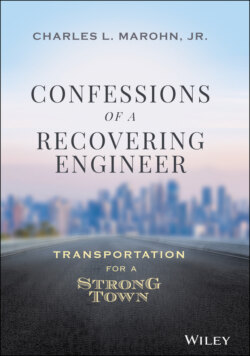Читать книгу Confessions of a Recovering Engineer - Charles L. Marohn Jr. - Страница 16
Hierarchical Networks
ОглавлениеTraffic engineers and transportation planners classify streets and roads according to their status in a hierarchy. Classification is determined based on how much traffic the street or road handles, or how much it is expected to handle.
The smallest of these with the least amount of traffic are called “locals.” They provide access to “collectors,” which collect traffic and funnel it to “arterials.” Sometimes a community will have “major arterials,” which is another step up the ladder of intensity. Theoretically, these different streets form a cascading system with many small streets emptying into fewer large streets.
Locals
Collectors
Arterials
Major Arterials
There is an obvious tradeoff in this hierarchy between what engineers call “mobility” and what they refer to as “access.” Consider a cul-de-sac, the ultimate local street. A cul-de-sac provides plenty of access to the properties along it, but it does not provide much in the way of mobility. It is a dead-end street that is not expected to handle many vehicles. In contrast, an interstate is the ultimate major arterial, providing lots of capacity for vehicles to move at high speeds but with limited access to adjacent property.
With these two as the extreme endpoints, a standard classification analysis gently blends the tradeoff between mobility and access as we move from cul-de-sac to interstate. We can impair the mobility of the interstate to provide a bit of access, and we can give up some local access on the cul-de-sac to improve our mobility. This is a simple and comfortable relationship best represented in Figure 2.1.
The relationship in Figure 2.1 is firmly grounded in the profession's priority values of speed and volume. Note the apparent happy compromise in the middle where we can have our transportation cake and eat it, too. Those are the collectors, where there is a lot of access but still plenty of mobility. At least, that is the way a transportation planner might explain it.
Another way is to note that collectors combine high travel speed with complexity. Collectors facilitate the flow of traffic at speeds above what is safe for a local street with a lot of access, yet they provide just enough access to ensure that there will be random starts and stops, turning movements, and people walking around outside of a vehicle. High speeds combined with complexity create environments that are extremely dangerous.
Figure 2.1 Relationship of functionally classified systems in serving traffic mobility and land access.
It would be dangerous enough if State Street were designated a Collector. State Street, which runs through the heart of Springfield, is actually a Principal Arterial, a designation often used for highways.
